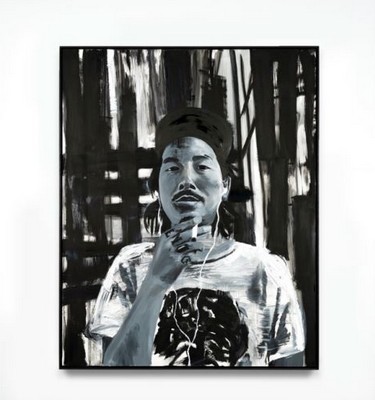Glenn Kaino
Walking with a Tiger
Pace Gallery, New York
January 12 – February 24, 2024
Daniel, 2023
© Glenn Kaino, courtesy Pace Gallery
Pace presents an exhibition of new work by GLENN KAINO at its 540 West 25th Street gallery in New York. Tthe show, titled Walking with a Tiger, marks Glenn Kaino’s first major exhibition with Pace since he joined the gallery’s program in 2021. The presentation brings together 18 new artworks—including paintings, embroideries, and sculptures—created by the artist in 2023.
Known for his multidisciplinary, activist-minded practice and collaborative approach to art making, Kaino has explored a wide range of political, social, and environmental issues in his work across mediums. In his paintings, sculptures, installations, performances, films, and monumental public works, the artist examines the roles that empathy and subjectivity can play in dismantling oppressive power structures and effecting real change.
For his first full-scale exhibition with Pace, Glenn Kaino shows a selection of deeply personal works centering on his family history and identity as a Japanese-American. With new paintings, embroideries, and sculptures, the artist has, for the first time in his career, turned his gaze inward to his own history, memories, and experiences. Glenn Kaino’s decision to engage in this more intimate kind of storytelling—as opposed to the macro-scale social issues he has explored in much of his past work—evolved from Glenn Kaino: Aki’s Market, a multifaceted installation centering on his grandfather’s life in East LA, on view at the Japanese American National Museum in Los Angeles through January 28, 2024. Glenn Kaino’s show in New York addresses these personal concerns with the same rigor, inventiveness, and humor that has defined his approach to art making and scholarship.
Walking with a Tiger raises questions about the Asian-American diaspora, a subject that has been largely ignored in cultural production until very recently, as it relates to the past, present, and future alike. Based on original photography, Glenn Kaino’s portraits—including friends, musicians, and individuals he encountered on the streets of LA— are acts of visibility, bringing new representations of Asian-Americans into conversation with one another and foregrounding enactments of intergenerational communion within the exhibition. Through gestural processes of accumulation and erasure, Kaino uses his brushstrokes to partially obscure various features of the paintings’ subjects, suggesting a disruption or slippage in the fabric of time and a tension between the background and fore.
For the new embroidered works in the exhibition, the artist draws on the history of bunka shishu, Japanese punch embroidery that was popularized in the Japanese-American community during the postwar years as a kind of paint- by-numbers for fiber arts and served, for many, as a link to the past. Departing from the instructions within the kits as he has done in his previous 'Kitbash' works, Kaino has invented a new stitch that he utilizes alongside traditional methods. The threads in these works are long and loose, extending embroidered images of tigers, storks, and Kabuki figures well beyond the confines of the picture plane; in some cases, the artist sews images directly together. Japanese tigers are of particular interest to Kaino as symbolic meditations of a romanticized homeland, given that the creature has become part of Japanese iconography and mythology despite having never been indigenous to the country.
The exhibition also includes a selection of bronze sculptures based on kabuto, a type of helmet used by samurai. In Glenn Kaino’s hands, this traditional Japanese armor has been reinterpreted through a contemporary lens. Each of these works is an amalgamation of structures and styles—combining baseball caps or Kangols with futuristic, embellished forms that protrude into space, declaring their Asian-American history by incorporating distinctly American wares. Displayed atop wooden plinths, Kaino’s helmets will also feature decorated interiors composed of kimono fabrics and woven shoelaces from sneakers. These sculptures speak to the ways that the form and design of relics can endure through the ages, generating new meanings and connections by way of the artist's hand.
Glenn Kaino is the co-curator of the Hammer Museum’s forthcoming Pacific Standard Time exhibition Breath(e): Towards Climate and Social Justice, and his newly commissioned public works for LA’s 6th Street Park and MTA LAX Metro Connector will be unveiled in 2026 and 2024, respectively. Last year, he exhibited his large-scale installation Bridge (Raise Your Voice in Silence) (2021)—a work produced as part of his decade-long collaboration with Olympic track and field athlete Tommie Smith—at Pace’s gallery in New York. He also recently presented a long-term exhibition, In the Light of a Shadow, at MASS MoCA in North Adams, Massachusetts.
GLENN KAINO (b. 1972, Los Angeles, California) is known internationally for his expansive vision and activist-minded practice, which encompasses painting, sculpture, installation, performance, monumental public art, theatrical production, and feature film. Focusing on equity, social justice, and climate change, among other urgent topics, the artist’s work traces through lines among various art historical movements, including Arte Povera, Conceptualism, and performance art. A relentless optimist, Glenn Kaino creates work imbued with hope, revealing structures of power and domination and creating opportunities for direct action and progress, all rooted in the belief that cultural production can affect real change. Glenn Kaino often highlights the illusionistic and mesmeric effects of scientific and natural phenomena in his large-scale installations to explore notions of empathy and subjectivity and to bring legibility to the often-invisible forces that shape our world.
PACE GALLERY NEW YORK
540 West 25th Street, New York City

